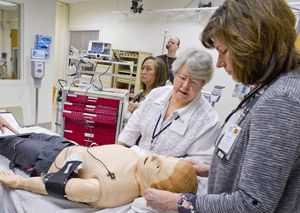Palo Alto Setting for VHA Clinical Simulation Instructor Training
By Gerald Sonnenberg EES Marketing and Communication
PALO ALTO, CA — Fifty aspiring clinical simulation educators across varied disciplines, such as physicians, nurses and associated health care providers, participated in several SimLEARN Palo Alto Clinical Simulation Instructor Training Courses in February through May. The primary purpose of the training was to help build a cadre of qualified VHA clinicians who can facilitate health care training that makes use of simulation modalities.
The five training events were a cooperative effort between SimLEARN, VHA Palo Alto Health Care System (PAHCS) and Stanford University. Under the guidance of PAHCS faculty, the future simulation educators learned the safe use of equipment and techniques, how to develop appropriate learning objectives and simulation scenarios and the art of conducting an effective debriefing. They also gained awareness of ethical and regulatory considerations that impact simulation education.

Participants of the SimLEARN Palo Alto Clinical Simulation Instructor Training Course practice a procedure on a mannequin during a simulation exercise in February Photos by Curt Campbell, Medical Media
For Ms. Emily Larimer, a registered nurse and clinical educator from the Black Hills Health Care System in Ft. Meade, SD, the Palo Alto training was her first experience with SimLEARN.
"This training provided us with a myriad of educational modalities and resources," she said. "It also provided us an introduction and application of the Crisis Resource Management (CRM) paradigm concerning the setting of health care."
Dr. David Gaba, staff anesthesiologist at the PAHCS, has conducted ground-breaking research in CRM in clinical care settings. He designed and led the CRM-oriented simulation instructor training taught during the sessions. CRM was initially developed for the airline industry after the crash of Eastern Airlines flight 401 in 1972. It is a technique that requires air crews to divide the work in the cockpit among available crew, ensuring that someone focuses on flying the plane while troubleshooting continues.
"The awareness and application of this paradigm assisted us in creating objective and significant outcomes within the health care setting," explained Ms. Larimer. "The paradigm awareness guided us to remain focused and, ultimately, led to effective learning objectives concerning the participants within the simulation scenario and debriefing session."
The use of simulation is gaining wide-spread acceptance in health care education, and due to the emergence of simulation as a tool for clinical education, there is a lack of experienced clinicians who can integrate simulation into training programs at VA health care facilities.
"This training experience will impact our simulation endeavors as we continue to process all we learned," added Ms. Larimer.



















